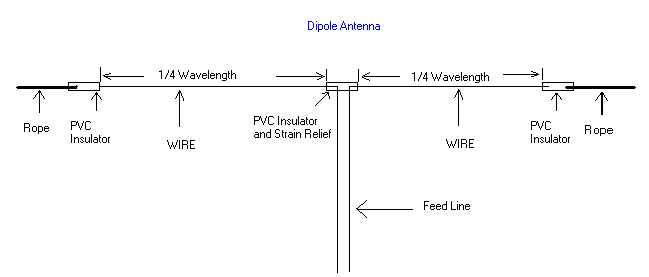DIPOLES
Antenna most often used by Hams around the world
Inexpensive, effective and easy to build, what more could anyone ask for in a home made antenna?
468/Fmhz will provide the length of the dipole element. I suggest adding 2 feet to this measurement
to be used for securing the antenna to the insulators. Fold the wire in half an cut it into two equal
lengths. Remove 6 inches of insulation from both ends of both wires. This is the two extra feet that
was added. Use 492/Fmhz for inverted "V".
Cut 3 pieces of 3/4 or 1 inch PVC pipe each about 6 inches long( length is not critical) To verify
that the PVC does not have a high metallic content place a section of it along with a cup of water
( to prevent damage ) in a microwave oven. Heat on high power for one minute. If the PVC pipe
is HOT don't use it, if only warm then it is OK for use as an insulator. At about 1 inch from the
ends, on both ends of all three insulators drill holes ( inline as much as is possible on each) about
1/4 inch in diameter.(the wires and ropes will be attached through this holes) A coat of spray paint
will triple their life span.(PVC becomes brittle when exposed to UV)
Insulated or uninsulated wire is your decision. I use insulated, it provides some protection from
the weather and corrosion you do however lose 0.3 db due to dielectric heating. For strength
use 14 gauge or larger stranded wire. Solid wire will also work but breaks much more easily.
The feed point impedance of a dipole that is suspended 1/2 wavelength above ground is 72 ohms.
Feeding it with 75 ohm coax results in a nearly perfect match, However, finding 75 ohm coax with
a high power rating has always been a problem. Using 50 ohm coax provides a SWR of 1.5: 1
which is quiet acceptable. If you care to invest the money, a commercial 1 to 1 balun can be used, or
you can make your own by coiling 6 turns of coax into a loop about 6 to 8 inches in diameter, secured
with electrical tape or nylon ties. This loop is attached to the center insulator and acts both as a balun
and strain relief for the coax. Bring the feed line away from the antenna at a 90 degree angle for as far
as is possible. If you mount the dipole vertically it should be at 90 degrees for at least 1/4 wavelength.
I have in the past suspended one dipole and it's coax vertically from another that was horizontal.
The radiation pattern of a dipole is a figure "8" at 90 degrees from the wire. While this is true the
dipole is nearly omni-directional. Should you favor stations to your east or west, erect the dipole
running north and south or vice versa. While this is not critical in most cases, every little bit helps.
Putting It All Together
The ends are simple, loop the uninsulated portion of the wire through one hole of the insulator and
wrap it tightly around itself. Use the smallest possible loop through the insulator and solder. Loop
the rope that you are using to support the antenna through the hole at the other end of the insulator
and tie it securely.( i often tape over or use a nylon tie over the knot just as insurance)
The center is a bit more complicated (but not much). Pull the wire through the hole and wrap it back
on itself one time, solder the wire at this point leaving the end free to attach to the feed line. Do
the same on both sides. Wrap the feed line around the center of the insulator at least twice if
using coax an secure it in place with nylon ties, leaving enough free to attach to the wire elements.
(don't forget your coax balun) Solder the feed line to the wire, seal the end of the coax and all
the exposed wire with silicon compound to keep out water.
Pull it up ( the higher the better, at least 1/2 wavelength above ground if at all possible)
and check the SWR, it should be below 1.5:1.
Using the same technique you could build a full wavelength dipole, feeding it 1/4 wave
length from one end. 936/Fmhz or a 1 and 1/2 wavelength center feed.
The thing to remember is that you need an odd multiple of 1/4 wavelengths on either side of
the feed point.(1/4,3/4,5/4,7/4)
As the elements get longer the radiation pattern comes more in line with the wire elements and
the gain increases.
Happy Hamming. 73's

